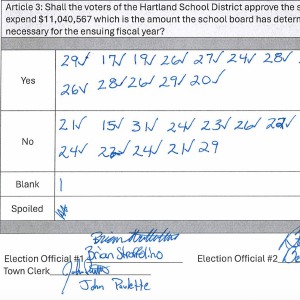Jim Kenyon: Bad trap gives a bad rap to legal animal capture
| Published: 01-08-2023 4:16 AM |
When Pete Stever, who trapped his first muskrat at age 12 on his family’s farm in West Fairlee, heard about what had happened in East Corinth last month, he knew immediately what it meant.
“It doesn’t look good,” he said. “It only takes one bad egg to ruin it for everybody.”
On Dec. 20, a 3-year-old Shetland sheepdog named Clara died after she was caught in what appears to have been an illegally set trap in the woods near a walking path off Chicken Farm Road in East Corinth.
The Vermont Fish & Wildlife Department has yet to comment beyond saying its investigation is ongoing.
Trapping is a lightning-rod issue. Animal rights activists argue trapping fur-bearing wildlife, ranging from bobcats and coyotes to beavers and mink, is cruel and unnecessary. Supporters say trapping is an important wildlife management tool and speaks to Vermont’s rural heritage.
Last year, Fish & Wildlife hired Responsive Management, a Virginia-based natural resource research company, to ask Vermonters about the state’s conservation efforts. Of residents surveyed, 60% “strongly or moderately supported regulated trapping.” Less than one-third — 29% — strongly or moderately disapproved.
A unsuccessful bill in the Legislature last year called for banning the activity, except when needed to eradicate nuisance wildlife. The avoidable tragedy in East Corinth undoubtedly gives anti-trapping advocates more ammunition in Montpelier.
“As liberal a state as Vermont has become, I’m surprised we’ve been able to hang onto trapping this long,” Wes Mattern, of Tunbridge, told me.
Article continues after...
Yesterday's Most Read Articles
 Hartland voters successfully petition for school budget revote
Hartland voters successfully petition for school budget revote
 JAG Productions announces closure, citing ‘crisis facing the arts’
JAG Productions announces closure, citing ‘crisis facing the arts’
 Hanover’s Perreard may soon capture the attention of collegiate coaches in two athletic pursuits
Hanover’s Perreard may soon capture the attention of collegiate coaches in two athletic pursuits
Mattern, 76, is a legend in trapping circles, Stever said. In the late 1970s, Mattern left a fur auction with a check for $10,000 in his pocket. “That was big money back then,” he said.
The only trapping Mattern does these days is when he’s called by folks looking to keep a fox out of their chicken coops or coyotes away from their sheep.
This summer, he trapped a beaver whose dam was flooding a farmer’s field. For payment, Mattern gladly accepted a homemade pie from the farmer’s wife.
Coming to the defense of trappers (at least, law-abiding ones) won’t win me any popularity contests, including in my own house. But that’s not a first.
Vermont’s trapping season typically runs from late October to late December. (Beaver, muskrat and otter seasons continue through March.)
Along with getting permission from private landowners, trappers must attach tags to traps with their contact information. Apparently, the trapper in East Corinth did neither, or the case would have been easily solved.
“If your trap is not tagged, it means you’re up to something that you shouldn’t be,” said Bruce Baroffio, president of the Vermont Trappers Association.
By law, trappers must check land traps every 24 hours. When I dropped by the 56-year-old Stever’s farm on a recent Saturday, he was heading to check his trap line. “It’s a commitment,” he said, “but it’s my passion.”
Although not required under state law, Stever often puts up signs: “Pet owners take notice. Trapping in Progress.” He includes his name and phone number.
He also makes an effort to keep his traps 5 feet above ground by attaching them to trees or poles. Trapping for bobcat and fisher starts Dec. 1. Fisher season runs until Dec. 31, but bobcats can’t be trapped after Dec. 16.
In Vermont, trapping is “heavily regulated,” said Chris Bernier, a state wildlife biologist. It’s the state’s job to make sure trapping is done as “ethically and humanely as possible,” he added.
Under a bill passed last year in the Legislature, Fish & Wildlife officials are developing additional “best management practices” for trapping. The proposed changes, which are still a work in progress, include prohibiting the use of meat-based bait in body-gripping ground traps.
The “capture of domestic pets is a relatively uncommon practice,” according to a draft of the proposed changes posted on the department’s website.
But keeping body-gripping traps with meat-based bait 5 feet off the ground could help avoid a repeat of what happened in East Corinth for the simple reason that “dogs don’t climb trees,” said Baroffio, whose organization supports the Fish & Wildlife proposal.
It’s unclear whether the ground trap that killed Clara was of a permissible size under current state law. Presumably, the public will find out once the investigation is complete.
Last week, I called Anne McKinsey, Clara’s owner. On the fateful afternoon, McKinsey, a web designer who has lived in the village for a dozen years, started out with Clara on a trail they’ve used many times.
Corinth adopted a dog control ordinance in 2015, but it doesn’t require pets to be leashed, if they’re under verbal control. Clara was about 50 yards off the trail when she started to yelp. Unable to pry loose the metal trap, Mc-Kinsey carried the 30-pound dog through the woods. Clara died just before McKinsey reached her parked car.
I asked McKinsey if the experience has made her a supporter of a trapping ban. “I don’t really know where I stand,” she replied.
Still, there’s more the state could do to increase public awareness of when trapping season is underway and the precautions that pet owners can take, she said. She’d like to see the warning signs that responsible trappers such as Stever put up become mandatory.
People who want to see an end to trapping might not need the Legislature. In 2022, Fish & Wildlife estimates that only about 320 of the state’s 785 trapping license holders actively ran trap lines.
As demand has declined, fur prices have collapsed to the point that many trappers, after paying for gas, struggle to break even, Bernier said.
If Vermont continues to lose trappers — or trapping goes away altogether — it will come at a cost. And I’m not talking money from license sales, which accounted for only about $18,000 in state revenue last year.
Fish & Wildlife relies on trappers and the annual reports they’re required to file to better understand the state of Vermont’s furbearer population.
“Trappers are our eyes and ears,” Bernier said.
Jim Kenyon can be reached at jkenyon@vnews.com.

 At Dartmouth, hundreds protest ongoing war in Gaza and express support for academic freedom
At Dartmouth, hundreds protest ongoing war in Gaza and express support for academic freedom Over Easy: ‘A breakfast without a newspaper is a horse without a saddle’
Over Easy: ‘A breakfast without a newspaper is a horse without a saddle’ Lawsuit accuses Norwich University, former president of creating hostile environment, sex-based discrimination
Lawsuit accuses Norwich University, former president of creating hostile environment, sex-based discrimination
